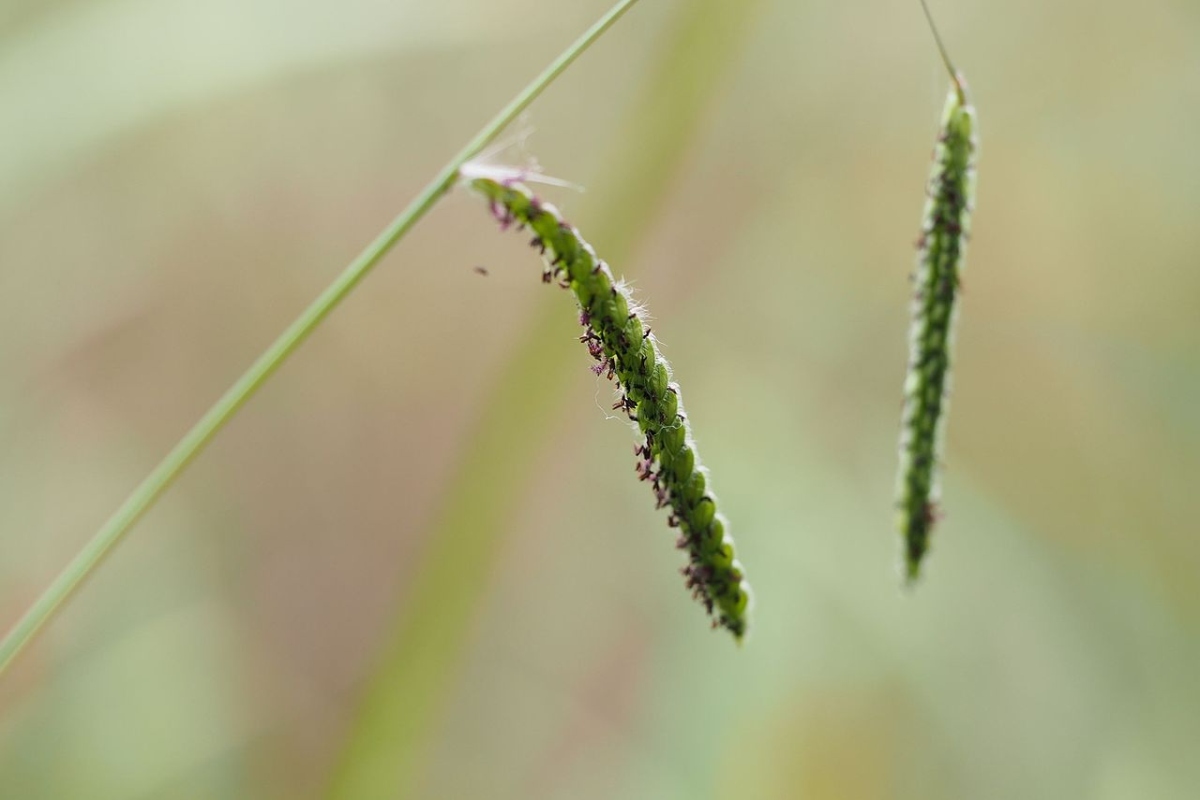
Weeds are a nuisance for homeowners everywhere, but especially in Georgia, where the warm weather fosters many different types of weeds in lawns and gardens. Problems with weeds go beyond the aesthetic – they can out-compete grass and plants for nutrients, sunlight, water, and space, interfering with your lawn and garden’s ability to grow well. To maintain a thriving landscape, learn how to identify and eliminate the most common Georgia weeds.
Dandelions (Taraxacum spp.)
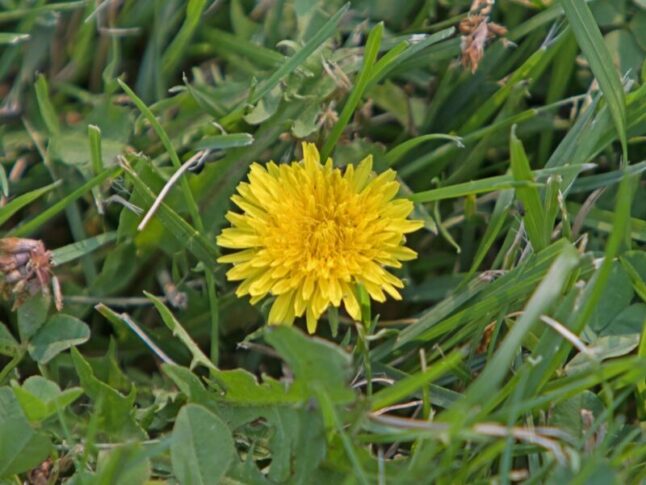
Dandelions are one of the most common weeds found in homeowners’ yards throughout the US, including Georgia. Although this weed has negative effects like disrupting a yard’s visual appeal, competing with other plants for resources like water and nutrients, and causing allergic reactions in some, dandelions have benefits, too. They are used medicinally and as a health food.
Dandelions are a type of broadleaf weed known for their yellow flowers and fuzzy white seed heads. The seeds are circulated into the air by the wind.
Despite their health benefits, dandelions are still a nuisance to many homeowners. They grow aggressively and spread quickly. One reason they are so common is that they can grow in many different soil types and conditions.
How to Manage Dandelions:
You can get rid of dandelions with mechanical methods or with herbicides:
- Mechanical Control: Damp soil makes it easier to pull up weeds, so extract them after rainfall or after you have watered the area. Use a weeding tool to loosen up the soil once it is wet, then pull out the dandelion by hand or with a weed puller. Be sure to remove as much of the taproot as possible.
- Chemical Control: If the dandelions cannot be removed by hand or there are several of them, spray them with a broadleaf herbicide. It will kill the dandelions and not the grass. Weed killers are toxic, so always read the label and follow all instructions.
Note: For any herbicide used, read labels, especially when applying them in your garden. Some herbicides are labeled to be used on specific vegetable crops or certain ornamental plants only. You can find herbicides that come with sprayers, wand applicators, or wicks that allow direct application to the weed to reduce the risk of damaging nearby plants and grass.
Crabgrass (Digitaria spp.)
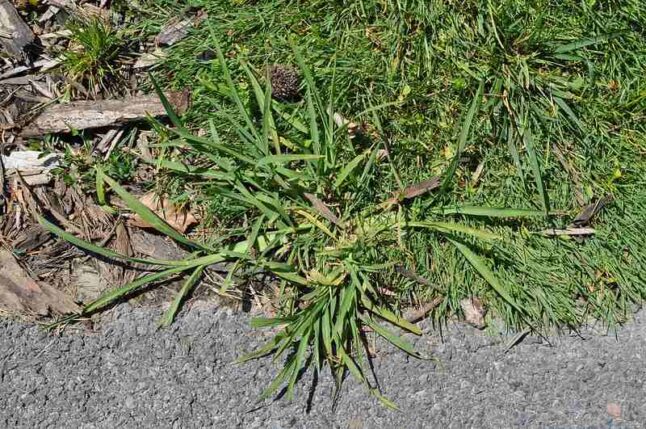
Crabgrass is identified by its light green color and long, narrow leaves. It has a coarse texture and can be easily seen when growing on dark green lawns. The seed head is produced in mid-summer and grows up to six inches.
You’ll commonly find crabgrass around patios and sidewalks. Crabgrass has seeds that look like small pine cones. This weed’s quick-spreading growth habit makes it a prime candidate to take over your Georgia lawn.
How to Manage Crabgrass:
Methods to get rid of crabgrass include mechanical and chemical options:
- Mechanical Control: If you have a few of these weeds, pull them by hand. Grab it by the base and extract it, pulling as much of the root system as you can. If necessary, use a dethatcher or hoe and scrape the top level of the soil before removing. Only pull if the seed head is closed. The seeds will spread and replant if you pull crabgrass when the seed head is open.
- Chemical Control: For weeds with open seed heads, let the weeds die off on their own in the fall. To prevent crabgrass in the future, use a pre-emergent herbicide in the spring before the seeds germinate.
Nutsedge (Cyperus rotundus)
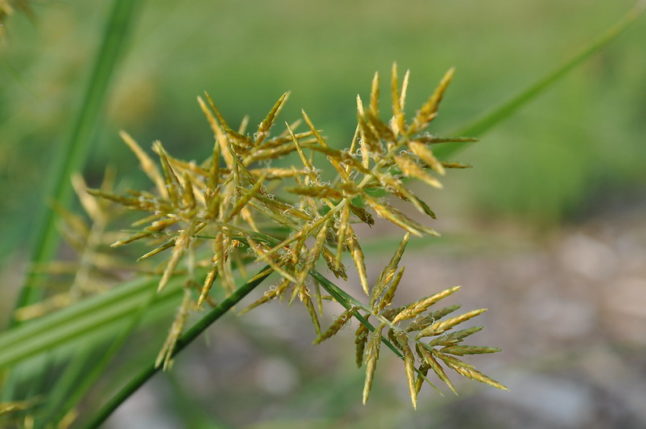
Although nutsedge looks a lot like grass, it grows taller than grass and has shiny green stems. Nutsedge is light green with triangular leaves that are long and narrow. This grass-like plant is commonly found in Georgia in the summer. It is a perennial sedge, so it will live for about two years and return annually. Nutsedge, in general, is difficult to control.
Yellow nutsedge sprouts yellow flowers at the tips of its leaf blades. It spreads by rhizomes, which are underground stems. When not mowed, yellow nutsedge produces a seedhead. However, the seeds do not usually germinate.
Each winter, the aboveground part of the weed is killed by frost. The underground portion, which is how the plant reproduces, goes dormant and survives. It can germinate and return the next season. Nutsedge can remain alive in the soil for over three years.
How to Manage Nutsedge:
You can control nutsedge with lawn mowing, mulch, and/or herbicides.
- Mechanical Control: Grass will crowd out nutsedge if the grass is mowed at the appropriate height. Mowing your lawn too short, however, encourages nutsedge growth.
For weeds with fewer than five leaves, pull them up by hand. Use a dethatcher or hoe if there are several weeds.
For nutsedge in gardens, laying down mulch is an optimal control method. Nutsedge reproduces by nutlets, also called tubers. Mulch blocks air and light from getting to these underground nutlets.
- Chemical Control: Use a liquid herbicide to spot-treat nutsedge. The leaves and roots will die in two to three weeks after absorbing the chemicals. Keep applying treatment as new weeds sprout.
Yellow nutsedge is best treated with herbicides or sedgicides that contain sulfentrazone or halosulfuron.
Chickweed (Stellaria media)
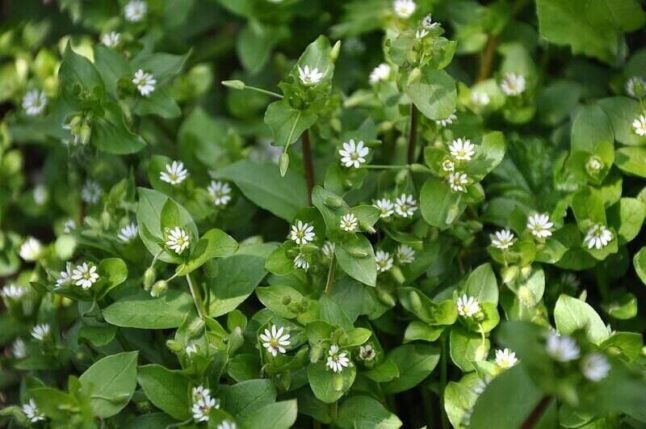
You can spot chickweed by its egg-shaped foliage and green stems with hairs on one side. It grows low and sprouts small, white flowers. The leaves grow in opposite pairs. Chickweed is an annual weed, meaning it dies after one season, but its seeds can remain alive in the soil for up to five years or more. Like dandelions, chickweed is used for its health benefits.
Despite its medicinal and edible qualities, many find chickweed to be a disruption to their garden and grass. Optimal conditions for chickweed growth are moist lawns that are cut low.
How to Manage Chickweed:
- Mechanical Control: Chickweed’s shallow roots allow it to be easily pulled out of the ground by hand. Remove as much of it as possible. Hand pulling may not kill the weed, however, if you don’t pull out the entire root system.
- Chemical Control: Use a pre-emergent herbicide in the fall before the weed germinates. A post-emergent herbicide can be used once chickweed is active.
Bittercress (Cardamine hirsuta)
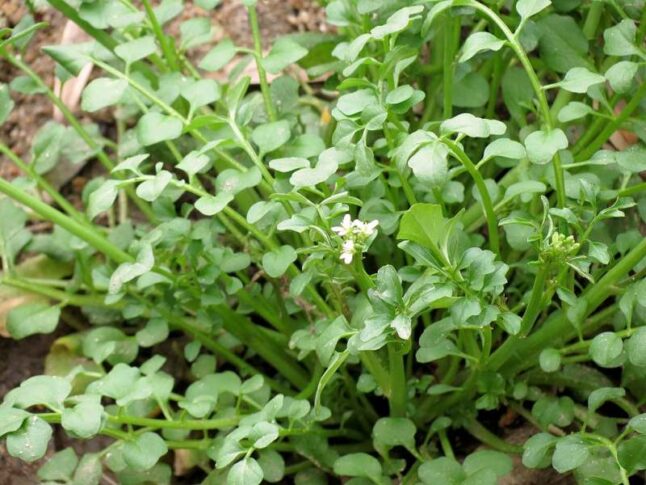
Bittercress is another Georgia weed that is edible but considered a nuisance. This weed has up to five leaf blades attached to stems that are frequently purplish at the tips. White flowers sprout in clusters at the tips of the stem. The flowers consist of four petals.
This broadleaf weed germinates in the late fall or winter. It goes dormant in the winter but will grow during periods of warm weather, including the spells of winter warmth Georgia is known for. Bittercress grows and develops seeds in the spring.
How to Manage Bittercress:
- Mechanical Control: Mowing grass often in early spring reduces bittercress by removing the flower stems. Thin and patchy spots encourage bittercress growth. Grow your grass thick and healthy to outcompete and inhibit weed growth.
- Chemical Control: Use a pre-emergent herbicide in the late summer or early fall. To control bittercress that is already active, apply a post-emergent herbicide.
Note: Most pre-emergent herbicides will also stop the germination of turf grass seeds.
Dallisgrass (Paspalum dilatatum)

Dallisgrass has green or grayish leaves with tall seed stalks. Each leaf blade has a vein that extends down the middle. Dallisgrass is easily confused with crabgrass. You can distinguish the two by their seed heads.
The seed heads of dallisgrass grow on the sides of the stem and have a coarse texture and black spots. The seed heads of crabgrass develop at the apex of the stem. Crabgrass seedheads are fine-textured and have no spots. Dallisgrass also has narrower leaves than crabgrass. Dallisgrass is one of the most difficult weeds to manage.
How to Manage Dallisgrass:
- Mechanical Control: Pull them up by hand if there are not many dallisgrass weeds and the weeds are still young, meaning no rhizomes or seeds have been produced. Use a tool, if necessary, to extract all of the roots.
- Chemical Control: Use a pre-emergent herbicide in March to keep the seeds from germinating. Apply post-emergent herbicide directly to dallisgrass clumps multiple times over two years.
Goosegrass (Eleusine indica)
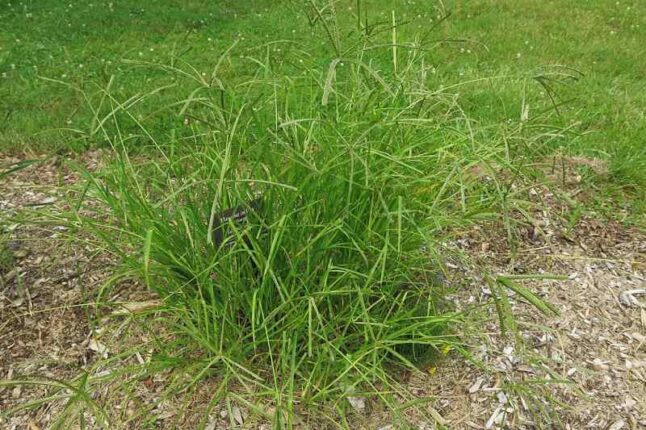
Goosegrass is another weed easily confused with crabgrass. Like crabgrass, goosegrass is light green. It reaches up to eight inches in height and has flat, narrow, fine-textured leaves. The seed heads develop in the late summer and germinate about three to four weeks after crabgrass.
You can tell crabgrass and goosegrass apart from their centers. The center of crabgrass is purplish, while the center of goosegrass is silver or white. Goosegrass’s blades are more spike-shaped than crabgrass’s foliage. Treatment is the same for both types of weeds.
How to Manage Goosegrass:
- Mechanical Control: If the infestation is just beginning and the weeds are young, pull them up by hand. Scrape the top layer of the soil to loosen it, and use a hoe or dethatcher for larger infestations. Remove the entire root system.
- Chemical Control: It is best to treat goosegrass with a pre-emergent herbicide in early to mid-May. Multiple applications may be needed. If using a post-emergent herbicide, multiple applications may be required, also. Post-emergent treatment is needed if the weeds have already sprouted.
Wild Onion (Allium canadense L.)
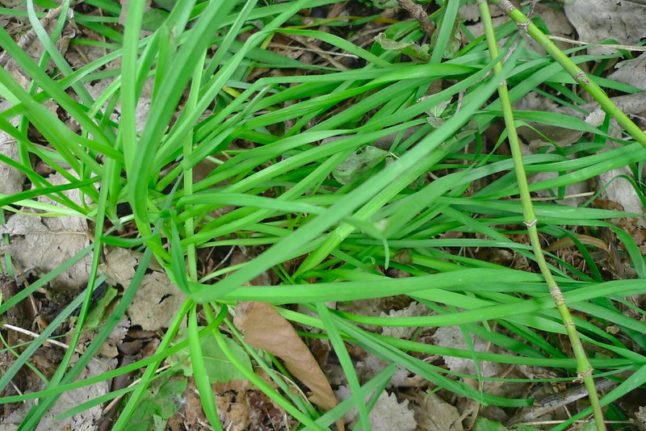
Wild onion (also known as onion grass) has green leaves and is grass-like. A cluster of whitish or pink flowers blossom at the top of the stems. The star-shaped flowering weed smells like onions, and the bulbs taste like onions, too.
Despite this weed’s edibility, many homeowners are turned off by the clumps it forms in their lawns. Wild onions can grow up to 18 inches tall. They sprout in the fall.
How to Manage Wild Onion:
- Mechanical Control: Wild onion can be pulled up by hand. However, when extracted this way, parts of it are left behind and can sprout again the next season. You can stop new bulbs from developing by mowing.
- Chemical Control: Unfortunately, there is no pre-emergent weed killer for this grassy weed. To treat it, post-emergent weed control must be used consistently.
For more information, see our article: “How to Remove Onion Grass.”
Henbit (Lamium amplexicaule)
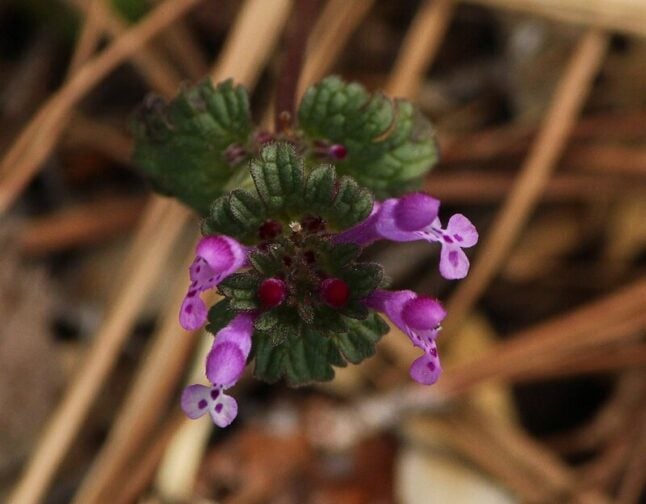
This annual broadleaf weed grows scalloped leaves that emerge in opposite pairs. The hairy foliage shares a purplish to greenish square-shaped stem with hairy purple flowers that appear in the spring. Henbit can reach heights of 12 to 16 inches. It spreads quickly and is most often found in the winter in thinning out lawns.
This weed species belongs to the mint family and is edible raw or cooked.
How to Manage Henbit:
- Mechanical Control: Maintaining a healthy lawn can decrease the risk of henbit growth.
- Chemical Control: Use a pre-emergent herbicide application in the fall. Post-emergent weed control applied with a handheld sprayer will allow the weed to be targeted specifically. It is best to use herbicides before the seeds germinate or when the weeds are being established.
Annual bluegrass (Poa annua)
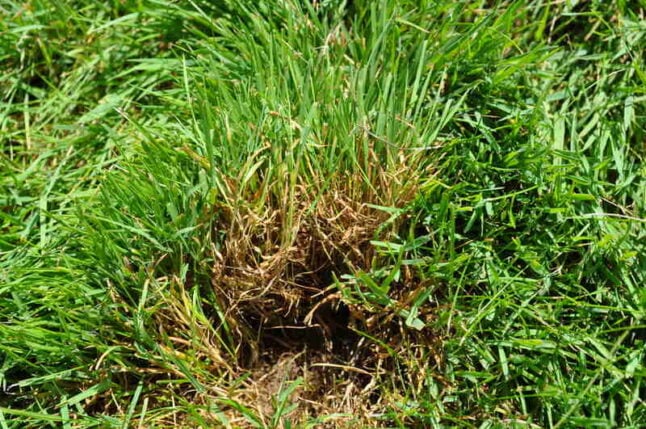
Annual bluegrass is very easy to identify by its silverish to white-colored seed heads. It is clump-forming and has light green foliage. It sprouts from fall through spring, flowers, and dies when the weather turns warm. Annual bluegrass produces hundreds of seeds during a season, which can remain dormant for several years before germinating. This characteristic makes it difficult to manage.
How to Manage Annual Bluegrass:
- Mechanical Control: Annual bluegrass thrives in wet soil. Not overwatering your grass is a prevention technique.
- Chemical Control: In the spring, apply pre-emergent weed control to stop the seed from sprouting.
Weed Control Management Tips for Georgia
The best weed control management is prevention. Here are some things you can do to reduce the chances of weeds invading your grass:
- Plant one of the best grass types for Georgia, which are adapted to the area and less prone to weeds than other grass types.
- Choose the right fertilizer for your grass type and apply it in the required amount at the right time of year.
- Do not water the grass too little or too much.
- Mow grass at the proper height and time interval during its growing season.
- Dethatch appropriately.
- Treat grass for insects and diseases.
It is important to keep in mind that a garden does not need to be completely weed-free. However, plants do grow better, especially fruits and vegetables, when they do not have to compete with other plants for resources. Here are some tips for weeding in your garden:
- Use mulch to prevent weeds from growing.
- Organic mulch decreases weed germination. Do not use grass clippings treated with pesticides or herbicides in edible plant gardens.
- Make sure you remove the tubers and roots that are underground.
- Pull up weeds before they flower and produce seeds.
- Remove weeds regularly, as needed, before they become excessive.
FAQ About Weed Control in Georgia
Weeds typically sprout in turfgrass that is thin or bare. When grass is mowed at the required frequency and height and receives adequate fertilization and watering, it is not as easy for weeds to invade.
Allowing too much space between plants can leave room for weeds to emerge. Mowers that have been used in areas with weeds can introduce new weed seeds into a garden.
However, most weeds that sprout in gardens are from seeds that developed in the garden in previous years. So, it is important to follow the weed control management tips explained earlier and do so throughout the seasons.
• The herbicide Image (1.5 lbs/gallon), containing imazaquin, is labeled for use to control yellow nutsedge, annual sedges, wild onion, and many other annual winter weeds. It is labeled for applying only to established Zoysiagrass and St. Augustine grass, two of the most shade-tolerant grasses for Georgia, as well as Bermudagrass and centipedegrass.
• Dismiss (4 lbs/gallon), which contains sulfentrazone, is labeled for application to the majority of major cool and warm-season grasses. It controls broadleaf weeds and sedges. Dismiss also inhibits goosegrass growth.
• Sulfosulfuron, which can be found in Certainty (75DF), selectively manages sedges. It is labeled for Zoysiagrass and Bermudagrass.
Like any other plant, weeds can be broken down into categories according to their life cycles. Weeds can be annuals, biennials, or perennials.
Annual weeds reproduce by seed. Their life cycle is less than one year. Summer annuals sprout during the spring. Lespedeza, goosegrass, and crabgrass are some examples.
Winter annuals sprout at the end of summer and the beginning of fall. They die when air temperatures are high, late in the spring, or at the start of summer. Henbit, common chickweed, and annual bluegrass are examples.
Biennial weeds germinate by seed and live for two years. They are not found in lawns as often as annual and perennial weeds.
Perennial weeds also propagate by seed and are typically harder to manage than annual weeds. Examples of perennial weeds include oxalis and plantain, which are also found in Georgia but are not as common as the other aforementioned weeds.
According to the Georgia Forestry Commission, plants are considered invasive if they are not native to the area and cause environmental or economic harm or detrimental effects to humans. Choosing plants that are native to Georgia’s USDA hardiness planting zone will help you select non-invasive vegetation. Here are some examples of invasive plants:
• Kudzu
• Multiflora Rose
• Japanese Knotweed
• Oriental Bittersweet
Pre-emergent herbicides prevent weeds from germinating. Post-emergent herbicides kill weeds after they have germinated.
There are some natural remedies to kill weeds that you can try. However, if weeds persist, you may have to use more harmful chemicals.
• Corn gluten meal can be applied as a natural pre-emergent treatment to henbit in early spring to prevent the seeds from germinating. If applied after germination, it can cause the weed to grow. Furthermore, moist soil can allow roots to absorb nutrients that promote growth. It is best to use corn gluten meal when it is going to be dry for two days, at least. It may be necessary to apply the meal every month.
• Boiling water or a herbicidal version of vinegar can be used on dandelions, and they can be pulled up once they have withered. Target each weed individually, or you can damage other plants and grass.
It depends on the kind of mushroom. Some mushrooms go away on their own, while others need removal by hand or treatments like baking soda, hydrogen peroxide, vinegar, or fungicides. You can learn more in our article: “What to Do About Lawn Mushrooms in Georgia.”
When to Hire a Pro
From the subtropical climate in the Western part of Georgia to the dry, more moderate continental climate in the Eastern region, different weeds thrive in different environments. They are like other plants, so they may appear at different times during the year, whether it is in early spring or late fall. It is best to proactively treat weeds by being on the lookout for them.
The sooner you get rid of them, the better, as it decreases the chances of the seeds germinating and spreading. Maintaining a healthy lawn and placing mulch in your garden are great ways to reduce your chances of lawn weeds.
You don’t have to do it alone. LawnStarter can help you find a qualified lawn care pro to keep your grass healthy. Whether you’re in Atlanta, Savannah, Augusta, Athens, or Macon, help is just a click away.
Main Photo Credit: harum.koh / Wikimedia Commons / CC BY-SA 2.0